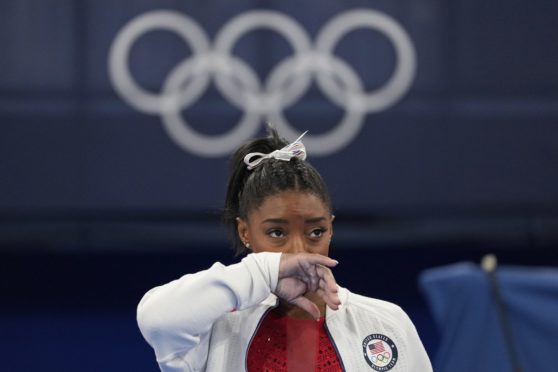There are two images which will live in my mind from these Olympics. The first is the smile on Simone Biles’ face when she finished her routine in the final of the beam.
It wasn’t a smile of triumph, though her routine was outstanding and won her a bronze medal.
It was a smile of deep, visceral satisfaction, emphasised by her classic, self-comforting gesture of tapping her own heart.
People have been talking recently as though mental health is a new concept in sports but in fact sports psychology has been a lucrative and powerful industry for over 40 years.
Before then coaches’ ideas of motivating athletes tended to be of the brutal variety.
Nell Hopman, who took an Australian women’s tennis team abroad, used terror tactics and underfeeding, to the extent that Margaret Court refused to go with her again.
She didn’t say it was because of her mental health though you have to wonder now.
Learning to lose is a valuable lesson
In the 1970s, we saw the ascendancy of sports science, with the result that no modern athlete is without access to psychological support and the elite ones are surrounded by their own personal teams.
The problem is, though, that sports psychology has been Thatcherite in nature, focusing on the science of winning – how to cure the yips in golf, how to reach the zone in competition, how to envisage yourself as a winner.
It forgets that learning to lose is often more important.
Those who questioned Biles’ courage and called her a quitter can’t have been there in training when she forced her body through endless repetitions of tiny, complex movements
Let’s be clear about one thing. Every single athlete we see in the Olympic Games is a winner.
Those who questioned Simone Biles’ courage and called her a quitter can’t have been there in training when she forced her body through endless repetitions of tiny, complex movements.
They can’t have been there when she won 30 World and Olympic titles, despite having to consult a sports psychologist to cure her of anxiety.
They can’t have been there when she went to A&E with a kidney stone the night before the 2018 World Championships, competing anyway and winning six medals.
It was courageous of her to withdraw from the Olympic juggernaut.
For an athlete of her stature to withdraw was like Princess Diana’s nerves about her wedding with Prince Charles.
When she told her sister of her misgivings, the sister famously replied: “Too late, Duch. Your name is already on the tea towels.”
Is comeback Simone Biles’ greatest move?
Biles’ name and smiling image were no doubt on all the US team merchandise, so yes, she was undoubtedly courageous.
But I admired her even more when she just went on and did it.
The concept of the twisties, the sensation of being lost in physical space, unable to orient yourself has haunted me since she talked about it.
How scary, when every movement you make defies gravity anyway – Simone Biles is reputed to be able to jump double her own height and watching her corkscrew into the air in her signature move, the Biles, I believe it.
I’ll forever be thankful for Junetendo ❤️ for allowing me to come train separately to try to get my skills back. The japanese are some of, if not the sweetest people I’ve ever met. https://t.co/2ZWrItJwAO
— Simone Biles (@Simone_Biles) August 4, 2021
She does so many twists that your eye can’t take in the number.
But athletes are immensely practical people – they measure their pulse rate, their weight, their stats against other athletes.
Simone Biles did a very practical thing – she reduced the difficulty of her dismount, practising over the last week to master the easier version.
It’s a shame she felt the need to stress she had permission from the doctors because she was the one who did something positive about her problem instead of staying with the negativity of victimhood.
Others choose to walk away
You don’t have to be a Piers Morgan lambasting the snowflakes to think that the progressive narcissisation of our society, started by my own baby boomer generation, the Me Generation, has gone too far.
I’m thinking about Naomi Osaka, too shy to speak to press who know about tennis but not too shy to pose in glossies like Vogue in a succession of floaty frocks which had nothing to do with her tennis and 125 mph serve.
She walked away, perhaps thinking she’d change the rules to suit herself – in the past she’d forced a tournament to start a day late by threatening to withdraw.
Vogue Hong Kong 🖤 pic.twitter.com/BSzLrdQNZw
— NaomiOsaka大坂なおみ (@naomiosaka) July 19, 2021
Simone Biles had the courage to try again, in the process ensuring her future mental health – how much more would it have eaten away at her to know she’d missed the opportunity to compete again in the Olympics?
The second image that will stay with me from these games is from the 800 metre women’s final.
Athing Mu, the teenager who ran, no, glided away from the rest of the field, looked like a goddess, a being from another planet.
Tall, graceful as a cheetah… watching her moving was like watching the most inspiring and beautiful work of art.
And there behind her, chasing the goddess, was the smaller British girl, Keely Hodgkinson, an ordinary human, toiling away and never giving up.
Winning and losing are about much, much more than medals.
Jean Rafferty is an award winning journalist, also a novelist, the author of five books, a number of pamphlets and countless articles.

